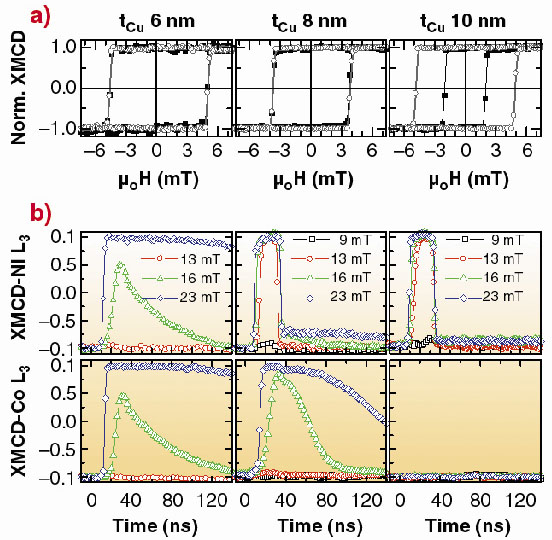- Home
- Users & Science
- Scientific Documentation
- ESRF Highlights
- ESRF Highlights 2001
- Magnetism and Electronic Properties of Solid
- Element-selective Nanosecond Magnetisation Dynamics in Spin Valves
Element-selective Nanosecond Magnetisation Dynamics in Spin Valves
Sub-nanosecond dynamics of magnetisation reversal in thin magnetic films is essential for the future of magnetic recording and non-volatile magnetic memories, where writing and reading times already approach the nanosecond timescale [1]. Commercial magnetic read heads use giant-magnetoresistance sensors based on spin valves, complex multilayer systems in which a soft free layer is separated from a hard magnetic layer by a non-magnetic metallic spacer. A complete understanding of the magnetisation dynamics of a spin valve requires the ability to probe the magnetisation of the individual layers as well as their mutual interaction. This investigation is possible with the time-resolved X-ray Magnetic Circular Dichroism (XMCD) measurements, which we have developed at the ESRF. As an example, we show results obtained for Ni80Fe20(5nm)/Cu/Co(5nm) spin valves.
XMCD experiments were carried out in single bunch mode on beamline ID12B. Time-resolution is achieved using a pump-probe (stroboscopic) scheme by synchronising the magnetic pulses created by a microcoil (pump) with the X-ray photon pulses (probe), at the repetition frequency of the ESRF (357 kHz). X-ray absorption is measured in fluorescence detection by mounting the sample in the gap of the microcoil. Chemical selectivity is obtained by tuning the photon energy to the Co L3 or the Ni L3 white lines to study the cobalt and the permalloy layers respectively.
The Ni80Fe20/Cu/Co sample is saturated in the negative direction by a static field applied along the easy magnetisation axis of the sample and a short positive magnetic pulse is applied to reverse the film magnetisation. The X-ray absorption of the two layers is measured at the selected energy as a function of the delay between pump and probe, for right (-) and left (
+) circular polarisation. The difference signal (
-
+) gives the XMCD vs. delay and therefore the time-dependence of the magnetisation of the probed layer. An average of about 105 pulses are needed to obtain a good signal-to-noise ratio.
The quasi-static magnetisation cycles, measured by XMCD (Figure 92a), show that for 6 and 8 nm of Cu the magnetisation of the two magnetic layers are aligned parallel, with Co and Ni80Fe20 reversing simultaneously in a coercive field of 4-5 mT. For 10 nm of Cu the magnetic layers are nearly uncoupled and two separate hysteresis curves are measured.
 |
| Fig. 92: Static and dynamic measurements of Co/Cu/Ni80Fe20 trilayers: (a) Static hysteresis loops measured by XMCD for the Co (open dots) and Ni80Fe20 (squares) layers; (b) Dynamic response of the permalloy (top) and cobalt layer (bottom) to pulsed fields from 9 to 23 mT and width 30 ns. |
The results of the dynamic measurements obtained with 30 ns-long pulses are shown in Figure 92b. For 10 nm and 6 nm of Cu the dynamic behaviour is similar to the static case. For 10 nm of Cu the two layers are uncoupled while for 6 nm of Cu the dynamic response is identical for the two layers.
In the 8 nm Cu sample the two FM layers are strongly coupled in the quasi-static regime but the dynamic reversal is different for the two layers. On the rising edge of the pulse, the two layers reverse with a different speed, the Ni80Fe20 magnetisation reversing well before Co. On the falling edge, the Ni80Fe20 magnetisation also decays faster than Co. However, a tail in the magnetisation decay shows that a fraction of the Ni80Fe20 layer remains coupled to Co. Apparently, in contrast with the static regime, there is a field range in the dynamic regime where a nearly antiparallel configuration between the two layers is achieved. This difference in magnetic coupling in static and dynamic regimes is illustrated here for the first time thanks to the chemical selectivity of XMCD. We attribute this behaviour to a difference in the reversal processes - dominated by domain wall propagation in the static regime, dominated by nucleation in fast dynamics [2].
References
[1] for a review see W.D. Doyle, S. Stinnett, C. Dawson and L. He, J. Magn. Soc. Jpn 22, 91 (1998).
[2] M. Bonfim, G. Ghiringhelli, F. Montaigne, S. Pizzini, N.B. Brookes, F. Petroff, J. Vogel, J. Camarero and A. Fontaine, Phys. Rev. Lett. 86, 3646 (2001).
Principal Publication and Authors
M. Bonfim (a), G. Ghiringhelli (b), F. Montaigne (c), S. Pizzini (a), N.B. Brookes (b), F. Petroff (c), J. Vogel (a), J. Camarero (a) and A. Fontaine (a), Phys. Rev. Lett. 86, 3646 (2001).
(a) Laboratoire Louis Néel, CNRS, Grenoble (France)
(b) ESRF
(c) Unité mixte CNRS/Thales, Domaine de Corbeville, Orsay (France)



